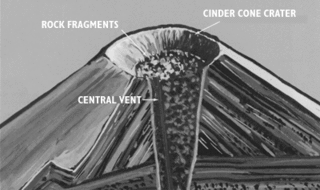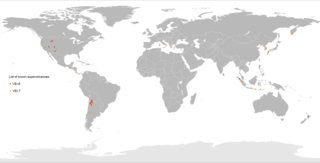
A supervolcano is a large volcano that has had an eruption of magnitude 8, which is the largest value on the Volcanic Explosivity Index (VEI). This means the volume of deposits for that eruption is greater than 1,000 cubic kilometers.

The Anahim Volcanic Belt is a 600 km (373 mi) long volcanic belt, stretching from just north of Vancouver Island to near Quesnel, British Columbia, Canada. The Anahim Volcanic Belt has had three main magmatic episodes: 15–13 Ma, 9–6 Ma, and 3–1 Ma. The volcanoes generally become younger eastward at a rate of 2 cm (0.8 in) to 3.3 cm (1.3 in) a year. The Nazko Cone, which last erupted only 7,200 years ago, is the youngest Anahim volcano. These volcanoes are thought to have formed as a result of the North American Plate sliding westward over a long-lived center of upwelling magma called the Anahim hotspot. The hotspot is thought to be similar to the one feeding the Hawaiian Islands.

Heart Peaks, originally known as the Heart Mountains, is a mountain massif in the Northern Interior of British Columbia, Canada. It is located 90 km (56 mi) northwest of the small community of Telegraph Creek and just southwest of Callison Ranch. With a maximum elevation of 2,012 m (6,601 ft), it rises above the surrounding landscape on the Nahlin Plateau, which is part of the western Stikine Plateau. Heart Peaks has been an area of prospecting since the 1980s with the discovery of precious metals.
Mathews Tuya is a tuya in northcentral British Columbia. It is one of the six tuyas close to Tuya Lake. It has been partly glaciated and Ar-Ar geochronology shows that is it about 730,000 years old. It mainly comprises palagonitized tephra but also has a few dykes and jointed lava flows on its flanks. The top still has flat-lying lava flows erupted after the tephra pile grew above the surface of the enclosing lake. The other volcanoes in the area include Tuya Butte, South Tuya and Ash Mountain. The volcanoes in the region form part of the Northern Cordilleran Volcanic Province.
The Pyramid, also called Pyramid Dome, is a young lava dome on the northeast flank of Mount Edziza in British Columbia, Canada. It is on the northeastern edge of the Tencho Glacier and represents several different styles of volcanic activity on the Mount Edziza complex. It is in the Northern Cordilleran Volcanic Province and last erupted during the Pleistocene period.
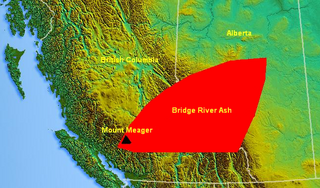
The Bridge River Ash is a large geologically recent volcanic ash deposit that spans from southwestern British Columbia to central Alberta, Canada. The ash consists of dust-sized shards ellipsoidal fragments of pumice. It overlaps the Mount St. Helens Yn Ash and the Mazama Ash which were erupted from Mount St. Helens and Mount Mazama about 3,400 and 6,800 years ago.
Sleet Cone is a cinder cone in northern British Columbia, Canada. It lies in the Desolation Lava Field and is thought to have last erupted in the Holocene period and is part of the Mount Edziza volcanic complex.
Storm Cone is a cinder cone in northern British Columbia, Canada. It is thought to have last erupted in the Holocene period and lies on the Desolation lava field which is part of the Mount Edziza volcanic complex.
Twin Cone is a cinder cone in northern British Columbia, Canada. It is thought to have last erupted in the Holocene period.
Cache Hill is a cinder cone in northern British Columbia, Canada. It is thought to have last erupted in the Holocene period. Once used as an airdrop for food and supplies by the Geophysical Survey of Canada, hence its name, it is located north of Raspberry Pass in Mount Edziza Provincial Park.
Sezill Volcano is a lava dome in Mount Edziza Provincial Park of northern British Columbia, Canada. It is thought to have formed and last erupted during the Miocene period. The volcano gets its name from being adjacent to Sezill Creek.
Camp Hill is a cinder cone in northern British Columbia, Canada. It is thought to have last erupted in the Holocene period.
Pharaoh Dome is a lava dome in northwestern British Columbia, Canada, located near Mount Edziza in Mount Edziza Provincial Park. It last erupted during the Pleistocene epoch.
Snippaker Creek Cone is a cinder cone of the Iskut-Unuk River Cones group in northwestern British Columbia, Canada, located near the western flank of Cinder Mountain. It last erupted during the Holocene epoch.
King Creek Cone is a subglacial mound of the Iskut-Unuk River Cones group in northwestern British Columbia, Canada. It last erupted during the Pleistocene epoch.
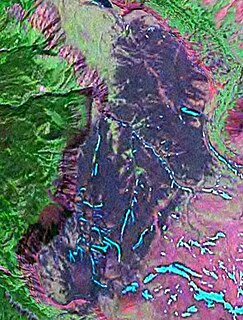
The Mess Lake Lava Field is a volcanic field associated with the Mount Edziza volcanic complex of the Northern Cordilleran Volcanic Province in northwestern British Columbia, Canada. It lies northwest of the Spectrum Range on the Kitsu Plateau and consists of young basaltic lava flows and tephra. The source for the basaltic lava and tephra was three cinder cones, including Mess Lake Cone and The Ash Pit, which may be the youngest volcanic feature of the Mount Edziza volcanic complex.
Thaw Hill is a cinder cone in northwestern British Columbia, Canada. It is one of the volcanoes in the central portion of the Mount Edziza volcanic complex and last erupted during the Pleistocene period.
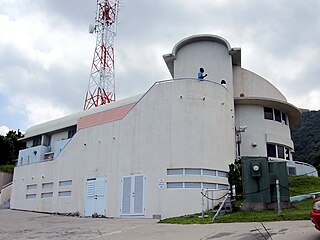
The Montserrat Volcano Observatory (MVO) is a volcano observatory which is located on the Caribbean island of Montserrat, where the Soufrière Hills volcano (SHV) has been actively erupting since 1995.
The Igwisi Hills are a volcanic field in Tanzania. Three tuff cones are found there, one of which is associated with a lava flow. They are one of the few locations of possibly kimberlitic lava flows on Earth.
